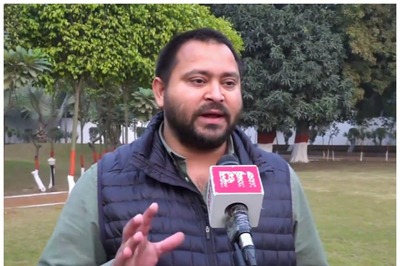
views
New Delhi: Niti Aayog has unveiled its much awaited 'Strategy for New India @ 75' document with an aim to accelerate growth to 9-10 per cent and make the country a USD 4-trillion economy by 2022-23.
Laying down a multi-pronged strategy to promote the country's overall development, the document said the annual growth rate of 9-10 per cent by 2022-23 would be essential for generating sufficient growth and achieving prosperity for all. Independent India will turn 75 on August 15, 2022.
"Steadily accelerate the gross domestic product (GDP) growth rate to achieve a target of about 8 per cent during 2018-23. This will raise the economy's size in real terms from USD 2.7 trillion in 2017-18 to nearly USD 4 trillion by 2022-23."
The strategy document further said besides having rapid growth, which reaches 9-10 per cent by 2022-23, it is also necessary to ensure that growth is inclusive, sustained, clean and formalised. The Indian economy grew at 6.7 per cent in 2017-18.
Unveiling the much-awaited document, Finance Minister Arun Jaitley said, "Sound policy will always put economy on track in which it will get perpetually people out of poverty and give them better quality of life."
The development strategy includes doubling of farmers' income, boosting 'Make in India', upgrading the science, technology and innovation ecosystem, and promoting sunrise sectors like fintech and tourism.
It also called for increasing the investment rate as measured by gross fixed capital formation (GFCF) from present 29 per cent to 36 per cent of GDP by 2022.
Noting that the country is now within sight of completing its economic transition as well, the document said, "India will see per capita incomes rising from about USD 1,900 in 2017-18 to around USD 3,000 in 2022-23.
According to the document, in agriculture, emphasis must shift to converting farmers to 'agripreneurs' by further expanding e-National Agriculture Markets (e-NAMs) and replacing the Agricultural Produce Marketing Committee (APMC) Act with the Agricultural Produce and Livestock Marketing (APLM) Act.
"The creation of a unified national market, a freer export regime and abolition of the Essential Commodities Act are essential for boosting agricultural growth," it noted.
Post release of the strategy document, Niti Aayog vice chairman Rajiv Kumar talking to reporters on agrarian crisis said, "Farm loan waiver is not a solution to farm sector distress. It is not a solution but is palliative."
Echoing Kumar, Niti Aayog member and expert on agriculture Ramesh Chand said the farm loan waiver is no solution to address distress in the agriculture sector. The document also suggested that to ensure maximum employment creation, codification of labour laws must be completed and a massive effort must be made to upscale apprenticeships.
It also made a case for successfully implementing the Ayushman Bharat programme including the establishment of 150,000 health and wellness centres across the country, and rolling out the Pradhan Mantri Jan Arogya Abhiyaan.
The document pitched for implementing the recommendations of the Second Administrative Reforms Commission as a prelude to appointing a successor for designing reforms in the changing context of emerging technologies and growing complexity of the economy.
It also called for expanding the scope of Swachh Bharat Mission to cover initiatives for landfills, plastic waste and municipal waste and generating wealth from waste.
According to the document, a new autonomous body, viz., the Arbitration Council of India, may be set up to grade arbitral institutions and accredit arbitrators to make the arbitration process cost effective and speedy, and to preempt the need for court intervention.
The Strategy for New India @ 75 document, prepared after extensive consultations with over 800 stakeholders from within the government central, State and district levels.
The Aayog had earlier planned to come out with three documents — 3-year action agenda, seven-year medium-term strategy paper and 15-year vision document. The forty-one chapters in the document have been dis-aggregated under four sections: Drivers, Infrastructure, Inclusion and Governance.
The document was prepared after extensive consultation with over 800 stakeholders from within the government central, state and district levels. Replying to a query on the GST, Kumar said the average rate will gravitate towards 15 per cent with increased resources and widening of the tax base.
"As the GST net widens, all these will gravitate towards average 15 per cent. It would be good rate if you compare with the previous indirect tax rate which used to be around 30 per cent. It will give impetus to consumption and economic growth," the Niti Aayog vice chairman said.
To a question on job creation, the Niti Aayog vice chairman said, "On the employment front, I am not sure crisis is appropriate word to use." "We are concerned with the employment situation. In fact, I am one of those economists who has said our policy targets could well be in terms of employment maximisation and growth will come out of that," he added.




















Comments
0 comment